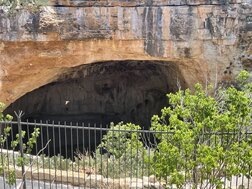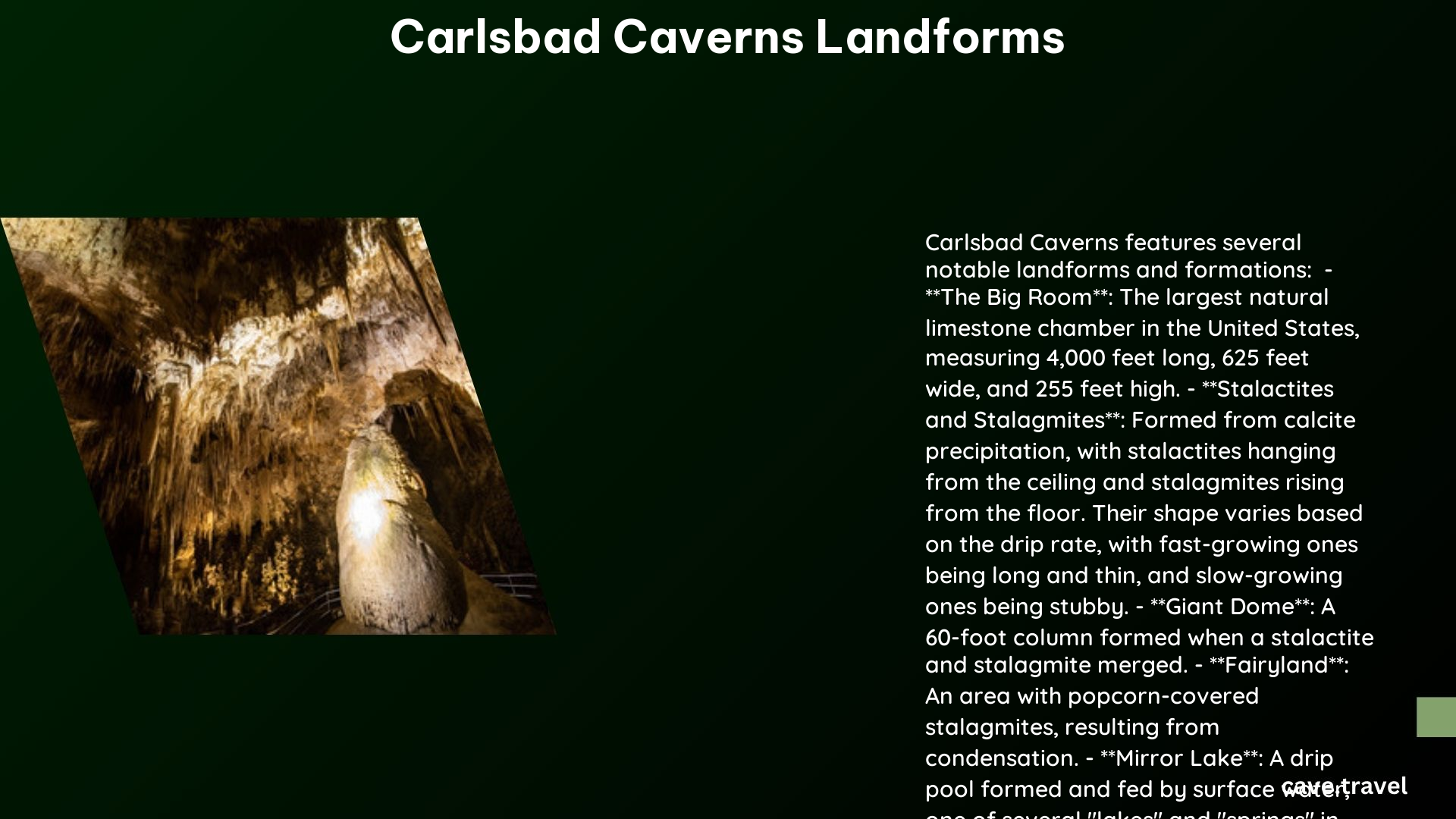Carlsbad Caverns, located in southeastern New Mexico, is a testament to nature’s artistry and geological processes. These caverns, formed over millions of years, showcase an array of stunning landforms and features. From vast underground chambers to delicate speleothems, Carlsbad Caverns offers a unique glimpse into the Earth’s subterranean wonders. This article explores the diverse landforms within Carlsbad Caverns, their formation processes, and the geological significance that makes this national park a world-renowned site.
What is the Geological History of Carlsbad Caverns?

The story of Carlsbad Caverns begins around 250 million years ago when the area was covered by a shallow sea. This ancient sea led to the formation of the Capitan Reef, a 400-mile-long horseshoe-shaped limestone structure. Over time, geological processes transformed this reef into the complex cave system we see today.
Key geological events:
- Formation of the Capitan Reef (250 million years ago)
- Sea evaporation and burial under salt and gypsum deposits
- Uplift and erosion exposing the buried reef
- Cave formation through sulfuric acid dissolution
- Speleothem development (starting 500,000 years ago)
How Did Sulfuric Acid Shape Carlsbad Caverns?

Unlike many caves formed by carbonic acid, Carlsbad Caverns owes its existence primarily to sulfuric acid. This unique process, known as sulfuric acid speleogenesis, played a crucial role in carving out the vast chambers and passages.
The sulfuric acid formation process:
- Rainwater seeps through cracks in limestone
- Water mixes with hydrogen sulfide from underlying oil and gas fields
- Sulfuric acid forms and dissolves limestone rapidly
- Large caverns and passages are created
This process resulted in the rapid formation of expansive underground spaces, setting Carlsbad Caverns apart from many other cave systems worldwide.
What Are the Main Types of Speleothems in Carlsbad Caverns?
Speleothems, or cave formations, are a hallmark of Carlsbad Caverns. These intricate structures form over thousands of years as water deposits minerals, primarily calcite, within the cave environment.
| Speleothem Type | Description | Notable Examples |
|---|---|---|
| Stalactites | Hang from the ceiling | Various sizes throughout the caverns |
| Stalagmites | Grow from the floor | Giant Dome (62 feet tall) |
| Columns | Formed when stalactites and stalagmites meet | Twin Domes |
| Draperies | Thin, sheet-like formations on slanted ceilings | Found in various chambers |
| Flowstone | Smooth sheets on walls or floors | Covers large areas in the caverns |
| Cave Pearls | Spherical formations in pools | Found in several locations |
| Lily Pads | Flat formations on pool surfaces | Seen in calm water areas |
| Rimstone Dams | Natural dams on cave floors | Create terraced pools |
| Popcorn | Small aragonite crystals | Decorates many surfaces |
| Helictites | Gravity-defying twisted formations | Rare and delicate structures |
What Are the Most Impressive Cave Features in Carlsbad Caverns?
Carlsbad Caverns boasts several remarkable features that attract scientists and tourists alike:
- Big Room: One of North America’s largest underground chambers
- Length: 2,000 feet
- Width: 1,100 feet
-
Ceiling height: 255 feet
-
Bat Cave: Home to a massive colony of Mexican free-tailed bats
- Population: Approximately 1 million bats (during summer)
-
Daily spectacle: Bat flight at sunset
-
Lechuguilla Cave:
- Length: Over 100 miles of surveyed passages
-
Significance: Fifth longest known cave in the world
-
Slaughter Canyon Cave:
- Notable formations: King’s Palace, Queen’s Chamber, Papoose Room
-
The Monarch: 89-foot column, one of the world’s tallest
-
Hall of the White Giant:
- Feature: Massive gypsum crystal
- Length: Approximately 30 feet
How Extensive is the Carlsbad Caverns System?
The Carlsbad Caverns system is vast and complex:
- Total explored passages in the main cavern: Over 30 miles
- Number of known caverns in the park: Over 100
- Deepest point in Carlsbad Cavern: 1,027 feet below ground
- Accessible depth for visitors: 755 feet (via elevator or hiking)
What Role Does Water Play in Shaping Carlsbad Caverns?
Water is the primary sculptor of Carlsbad Caverns, playing multiple roles in its formation and ongoing development:
- Cave Formation:
- Rainwater mixes with gases to form acids
-
These acids dissolve limestone, creating cavities
-
Speleothem Creation:
- Water carries dissolved minerals
- As water evaporates or loses carbon dioxide, minerals are deposited
-
Over time, these deposits form various speleothems
-
Ongoing Processes:
- Continuous dripping and flowing water reshapes the cave
- New formations are slowly created while others are modified
The interplay of water, rock, and time has resulted in billions of water drops forming thousands of cave formations over millions of years, making Carlsbad Caverns a dynamic and ever-changing environment.
How Does Carlsbad Caverns Contribute to Scientific Understanding?
Carlsbad Caverns serves as a natural laboratory for various scientific disciplines:
- Geology:
- Provides insights into karst formation processes
-
Offers examples of rare sulfuric acid cave development
-
Hydrology:
- Helps in understanding underground water systems
-
Demonstrates mineral transport and deposition processes
-
Biology:
- Supports unique ecosystems adapted to cave environments
-
Hosts significant bat populations, aiding in bat research
-
Paleontology:
- Contains fossils from ancient marine environments
-
Preserves evidence of prehistoric cave-dwelling animals
-
Climate Science:
- Cave formations record past climate conditions
- Aids in studying long-term climate changes
Carlsbad Caverns continues to be a valuable site for scientific research, offering new discoveries and insights into Earth’s geological and biological processes.
References:
- https://www.britannica.com/place/Carlsbad-Caverns-National-Park
- https://npshistory.com/publications/cave/index.htm
- https://www.geologyvirtualtrips.com/carlsbad-caverns-n-p
